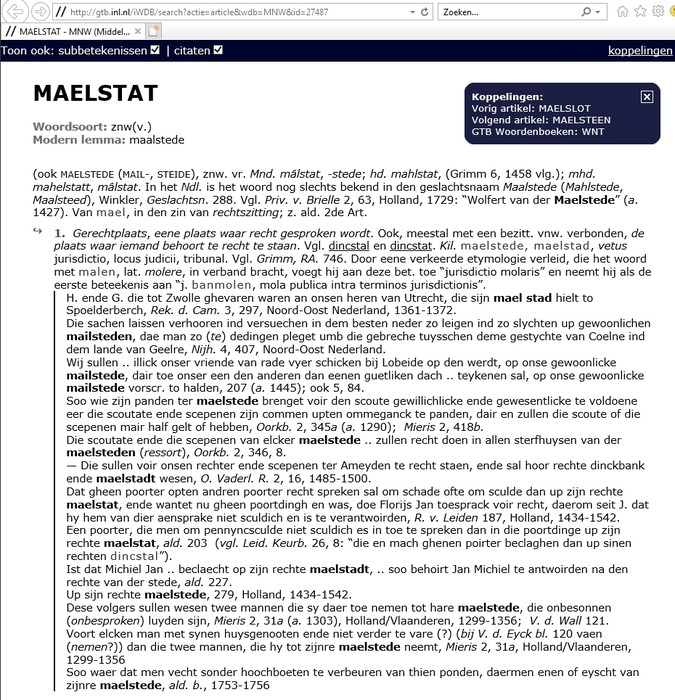Is often the name of a farm (Pollinkhove, Heuvelland) or of a (disappeared) castle (Ter Madelstede).

Answer
Dear Herman,
Fortunately, we can rely on the Historical dictionaries of the Institute for the Dutch Language for such a question: the Old Dutch Dictionary (ONW), the Early Middle Dutch Dictionary (VMNW), the Middle Dutch Dictionary (MNW) and the Dictionary of the Dutch Language ( WNT). These dictionaries have been worked on for more than one hundred and fifty years and you will notice that as a user: they contain a wealth of information about Dutch words and their origin. The MNW and WNT alone take up five linear meters in a bookcase, but fortunately all these dictionaries can now be consulted online completely free of charge, together with the Wurdboek fan de Fryske taal (Woordenboek der Friese taal, WFT). You can find them here: http://gtb.inl.nl
But then your specific question. Madelstede is a contraction of two elements: madel and stede. The second part means ‘place’ or ‘place’ (the modern word city is derived from it). The first part comes from the Old Dutch mathal that was used to indicate a meeting, more specifically a meeting where justice was administered. Madelstede was originally a place where justice was administered.
Because few Old Dutch sources (that is, sources from before the year 1200) have survived, we do not find any precursors of the word madelstede there. The form mathalstedi can be assumed on the basis of the Old Dutch stedi and a place name such as Malburgen (now a neighborhood in the Dutch city of Arnhem). That name is in ancient sources Malberg and that must have arisen due to the disappearance of sounds from the original mathalberg.
With the gradual transition from Old Dutch to Middle Dutch, the vowels in unstressed syllables became weaker (vogala became Vogele, for example). Through that process the supposed mathalstedi will gradually have been transformed into madelstede, the form you quote. In Early Middle Dutch sources (that is, sources from the thirteenth century) we mainly find the form maelstede. The fact that madel- here has become mael- is a good example of syncope, the loss of a sound. This is a well-known phenomenon that has led, among other things, to the coexistence of different forms: co next to mee, leather next to leather. In those thirteenth-century sources, maelstede is only used as an indication of a specific place or person (eg Jan van der Maalstede).
The general meaning of maelstede or maelstat as ‘place where justice is administered’ or ‘the place where one must stand trial’ is, according to the many quotations in the MNW, still well known in the Middle Ages (see illustration). Here and there, however, the word was also used more broadly for assemblies where important matters were discussed. There is also a development in meaning towards ‘legal residence’ (the place to which one is legally affiliated), a meaning that, according to the WNT, was still found in the seventeenth century. However, the names of the castle and farms you cite will be related to its original meaning: ‘place of justice’.
To answer this question I made use of the following articles (lemmas) in the Historical dictionaries:
-
ONW: mathal, mathalberg, stat, stedi
-
VMNW: maelstede, stat, stede
-
MNW: madelstede, maelstat, stede
-
WNT: mill, city

Answered by
Prof. dr. Dr Remco Sleiderink
Older Dutch literature, especially of the Middle Ages

Prinsstraat 13 2000 Antwerp
http://www.uantwerpen.be
.